Review of New Spectroscopic Instrumentation for 2018
Spectroscopy
Our annual review of spectroscopy products, broken down into the following categories: Atomic Spectroscopy, Florescence, Mass Spectrometry, Mid-IR, NIR, NMR and ESR, Raman, UV-vis, X-ray, Software, Accessories, Components
Pittcon introduced some significant changes in 2018. The most visible was the decrease in time for the exhibition from four to three days. On Tuesday (the first day), the exhibition floor was very active with what amounted to pent-up energy. However, we must also point out a decrease in the size of the exposition and the absence of some large vendors. There were large seating areas for interactions and even seminars, and the return of the Lab Gauntlet, where vendors present application solutions using their tools. The Gauntlet is a successful addition to the show, with a lot of energy and interest flowing down the aisle. Some presentations (Thermo Fisher Scientific) showed their new products in the Gauntlet, too, making it a continuation, in effect, of booth presentations.
Although Pittcon remains an important venue for the introduction of new products over the past few years, vendors are also increasingly announcing new products outside Pittcon. We therefore accept any new products announced during the past year for inclusion in this review, which covers new instruments, components, and accessories announced by vendors during 2017–2018.
Attendance in 2016 was 12,841 and attendance for 2017 was 14,144. This year's attendance was reported as 11,415 (1). The increase seen last year was attributed mainly to the improving economy. It's not clear whether or not the attendance number reflects only the reduced number of days for the show. Last year we hypothesized that Pittcon attendance might be what economists would call a "lagging indicator."
The exposition featured 714 exhibiting companies occupying 1404 booths, somewhat lower than last year's figure of 787 exhibiting companies. The reduced number of exhibitors might possibly be a result of the reduction of exhibition days to three. Of these companies, 93 were reported as being first-time exhibitors. Increased attendance may persuade more companies to exhibit in the future, as well.
There is a healthy pipeline of new products coming from a wide variety of vendors and application areas. It is good to see continued development around the classic techniques, like near-IR, mid-IR, and Raman spectroscopy. There is a lot of activity around accessories, too, where vendors strive to meet user-specific applications.
For the last couple of years, Pittcon did not present Editor’s Choice awards as it had done for many years previously. Last year, that event was replaced with Pittcon Total Excellence Awards. This year the Excellence Awards seem to have settled down into that new format. The award selection committee consisted of a blue chip panel of experts who evaluated the entries based on “ingenuity, creativity, implementation, and outcomes.” Companies are now segregated into small, medium, and large companies based on sales figures so that they can only compete with others in their class. Therefore, there were three awards of each type: gold, silver, and bronze. We are pleased to note that the following spectroscopy companies were winners of the Excellence Awards: In the $10,000,000– $100,000,000 sales category, B&W Tek won gold for its STRaman portable Raman analyzer; Metrohm won silver for its 946 Portable VA voltammetric analyzer; and CEM Corporation won bronze for its EDGE extraction system for sample preparation. In the greater than $100,000,000 sales category, Horiba Scientific won gold for its Duetta fluorescence and absorbance spectrometer (listed in Table III) and Shimadzu Scientific Instruments took home bronze for its IRSpirit FT-IR spectrometer (listed in Table V).
The review that follows is categorized by wavelength region or type of spectroscopy (such as mid-IR, X-ray, and so forth). We arranged our review to allow readers to compare instruments from different manufacturers, although this process sometimes groups handheld instruments with high-end research tools. The categories used to classify the products are
Accessories
Atomic spectroscopy
Components
Fluorescence
Mass spectrometry (MS)
Mid-infrared spectroscopy
Near-infrared (NIR) spectroscopy
Nuclear magnetic resonance (NMR)
Raman spectroscopy
Software
UV–visible spectroscopy
X-ray (includes higher frequencies)
Categories fluctuate from year to year, depending upon trends in the submissions and in the industry. The core spectroscopy headings are usually consistent, but marginal categories such as “imaging” have been transient and had no entries this year. Fluorescence has been absent for several years, and we are pleased to see it back as a category. As in the past, “accessories” are tools used in conjunction with an instrument (such as a sample preparation or ATR device), while “components” (such as lasers or detectors) are used within an instrument. The “software” category includes instrument control, collection and data processing programs, as well as products for storage and transmission of data and also collections of data, such as databases (libraries).
Broad Trends
Instrumentation is evolving, like the telephone, to cover a wider array of scientific problems. The high-end instrumentation remains solid, with mainly evolutionary changes: witness the increasing resolution of mass spectrometers. Meanwhile, another trend is reduction in size. For example, routine and field analysis is increasingly being taken over by handheld or portable devices, a trend that seems to be continuing.
The growth we saw in Raman last year continues, with ongoing improvements in the tools and a number of new systems being launched. New generations of small Raman spectrometers continue to appear. Both commercial and academic users of Raman are seeing more laser, detector, and optical options. With this market slated to maintain double-digit growth, we can expect this trend to continue for some time.
Near-IR (NIR) spectroscopy remains a solid method for many analyses, and there is lots of activity in this area. Multiple vendors introduced new tools for NIR, while others have modified existing products to extend their capabilities. The NIR field is not as strong of a growth vector for commercial vendors as Raman. However, it is a core piece of many industrial processes, indicating that we will also see continued developments and improvements in this line.
The largest number of new submissions came from the accessories area. As always, accessories divide generally into sample preparation tools and items intended for use in probe systems. The key factor, as always, for these vendors has been to recognize a need (like lowcost microtoming) and then devise a targeted tool.
Instruments are also evolving to detect ever-smaller sample sizes. More spectrometers are now reaching the same scales, such as the coupling of Raman and infrared to atomic force microscopes. In addition to microscopes being attached to various optical spectrometers, other couplings of instruments are starting to appear, such as combined terahertz and FT-IR (mid-IR) spectrometers, and combined mid-IR and Raman in a single unit. The ultimate in small sample size is, of course, the ability to detect and measure the spectrum of a single molecule. We also note that, despite reports from academia about single-molecule detection and characterization, no commercial device has yet appeared in that arena.
Three broad themes emerged from the new products announced to Spectroscopy and during Pittcon. Classic techniques saw activity. For instance, announcements included multiple tools for the age-old problem of sample preparation (grinding and pressing of samples) and new offerings in inductively coupled plasma (ICP) and FT-IR microscopy. There should be little surprise here-many of the problems faced by today’s laboratory workers are the same as those from 20–30 years ago. In spite of exciting developments at the cutting edge, there is plenty of basic chemistry that still needs to be done.
Second, while many vendors are marketing instruments similar to those from years past, the surge in new software developments is continuing. Developments center on two problems: matching the user interface to the problem and lowering sampling barriers. Enlarged databases and new algorithms are combining to provide customized, useful reports. Terrain-following software in microscopy is relieving the problem of focusing on an irregular sample over a large area. And collaboration is being enhanced using video cameras and touch screens to replace single-user eyepieces, allowing local and remote users to tackle problems as a team.
Third, Raman spectroscopy offerings continue to expand. At Pittcon, it seemed every aisle had Raman vendors differentiating their products by size (handheld, portable, or benchtop) and performance. The Raman effect was first observed in 1928, so Raman has had a long development cycle because of some very specific requirements that had to be met to make it a commercially viable technique. The most crucial tool has been the laser, and now many vendors provide multiple diode laser solutions in small packages with low power needs. Vendors can take the ingredients-lasers, miniaturized diffraction elements, and multichannel detectors-and combine them in a particular form factor to address a specific market.
We noted a trend a few years back toward application-specific analyzers. Although this trend seems to have slowed, many vendors have noted how their tools combine in certain markets. See, for example, the new Bruker electron spin resonance beer analyzer, and the Brimrose Seedmeister NIR analyzer. A new field around cannabinoids is growing. Legalization is opening up new applications in this burgeoning new commodity, which has increased the market for quality control and regulatory compliance. This rapidly evolving field historically is populated by highend instruments-for example, gas chromatography–mass spectrometry (GC–MS)-but now seeking low-cost solutions.
This Year’s Products
In each section of the review, every category lists products with a brief synopsis of capabilities as well as a more extensive list of capabilities.
It is always inevitable that some categories include products that might arguably be classified elsewhere, especially in regard to accessories, components, and software. Some hyphenated techniques, such as inductively coupled plasma–mass spectrometry (ICP-MS) could legitimately be listed in either location. In such cases, the authors usually respected the classification given by the manufacturer.
We also endeavored to provide a synopsis of salient features for each product, or at least as much as could be included in limited space. We follow a “features–benefit” format, so that not only are the key features of a given instrument described, but also the meaningfulness of those features to the user. Also, readers can search by company name or product category in Table I, which references the headings where the content will be found.
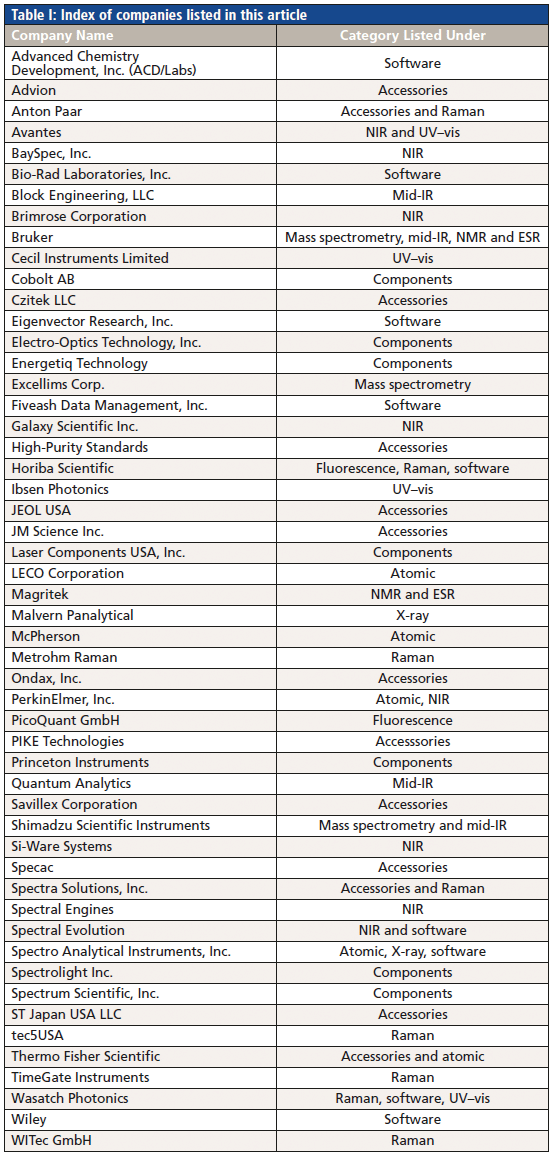
Atomic Spectroscopy
This year in the atomic spectroscopy category (Table II), several new ICP instruments with optical emission spectrometry (OES) or MS detection were introduced (PerkinElmer, LECO, and Thermo Fisher Scientific). Like other established methods, the main goals appear to be better detection limits and usability. Spectro Analytical also showed new portable units for the analysis of metals in the field. In recent years, we saw laser-induced breakdown spectroscopy (LIBS) moving in this direction as well.
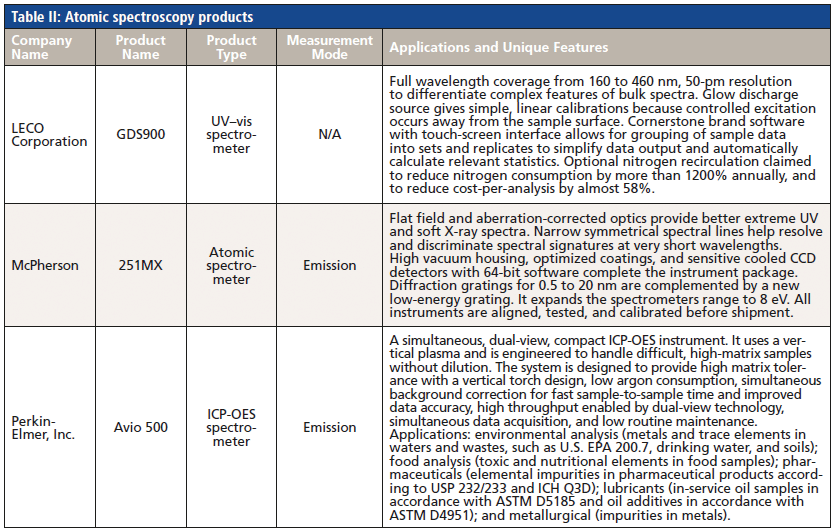
LECO has full wavelength coverage from 160 to 460 nm, with 50 pm resolution, to differentiate complex features of bulk spectra.
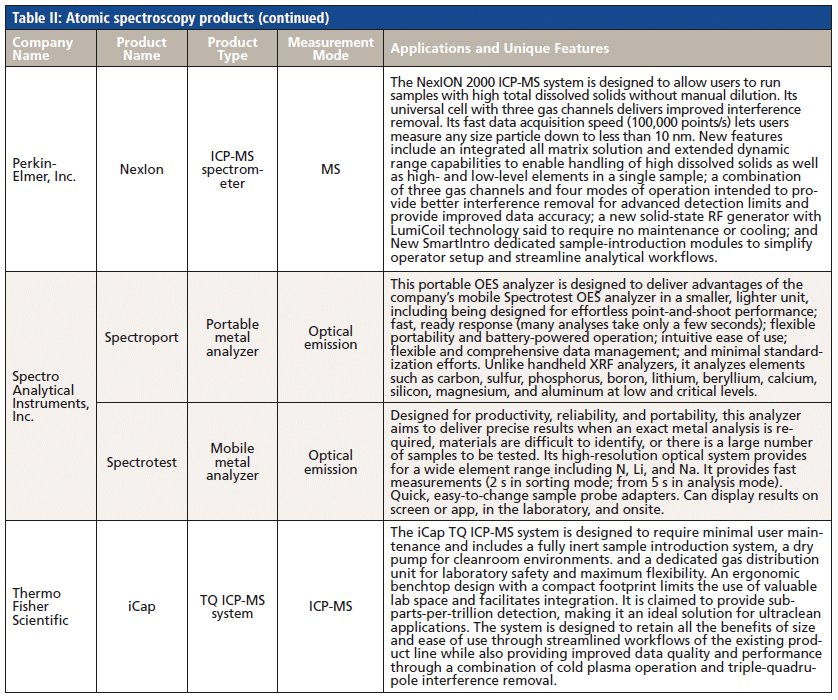
McPherson provides flat field and aberration corrected optics with better extreme UV and soft X-ray spectra. Narrow symmetrical spectral lines help resolve and discriminate spectral signatures at very short wavelengths. The systems include high vacuum housing, optimized coatings, and sensitive cooled charge coupled device (CCD) detectors.
PerkinElmer has the smallest ICP system on the market, with patented Flat Plate plasma technology that uses half the argon of other systems.
Spectro Analytical Instruments has a new advanced, portable OES analyzer that delivers many of the advantages of the company’s flagship mobile Spectrotest OES analyzer in a smaller, lighter unit.
Fluorescence
Probably the most innovative and exciting development in years for fluorescence (Table III) emerged from Horiba Scientific-an instrument that won best in show at Pittcon. A two-dimensional design allows the Duetta fluorescence and absorbance spectrometer to simultaneously collect-at amazing speeds- UV–vis–NIR absorbance spectra at the same time as the fluorescence is captured. This device should prove to be valuable in drug discovery laboratories and related fields in biophysics. A second new instrument, from PicoQuant, provides access to steady-state, lifetime, and phosphorescence.
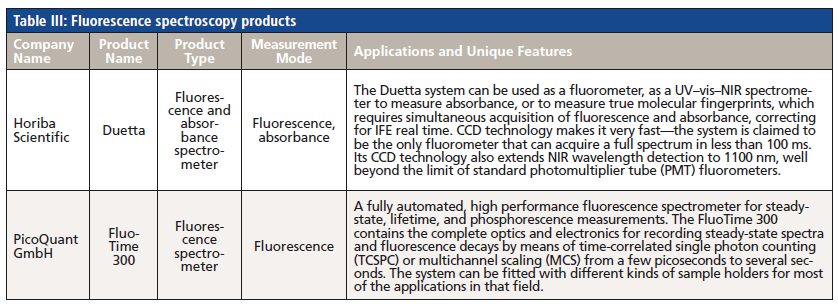
Horiba’s instrument can measure fluorescence and UV–vis absorbance spectra, and can also do both simultaneously
PicoQuant shows its FluoTime 300 fully automated, high-performance fluorescence spectrometer for steadystate, lifetime, and phosphorescence measurements.
Mass Spectrometry
A few new products were introduced in the MS category (Table IV) this year. For example, Shimadzu, introduced a matrix-assisted laser desorption–ionization time-of-flight (MALDI-TOF) front-end designed for efficient sample introduction.
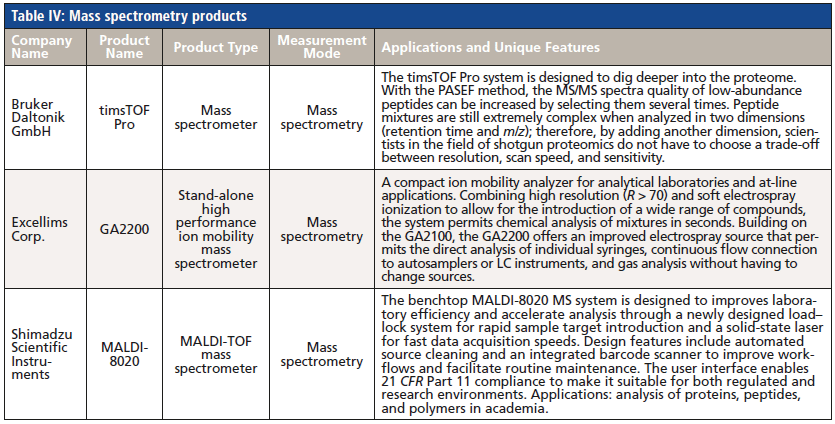
Bruker Daltonik offers a TOF mass spectrometer specialized to improve the analysis of the proteome.
Excellims shows a compact ion mobility analyzer for analytical laboratories and at-line applications. Combining high resolution (R > 70) and soft electrospray ionization to allow for the introduction of a wide range of compounds, the GA2200 analyzer permits chemical analysis of mixtures in seconds.
Shimadzu provides a benchtop TOF mass spectrometer that improves laboratory efficiency and accelerates analysis through a newly designed load–lock system for rapid sample target introduction and a solid-state laser for fast data acquisition speeds.
Mid-IR
In mid-IR (Table V), three different approaches to the infrared analysis of materials are reported in this year’s new developments. Quantum cascade lasers continue to appear in new configurations. The crowded field of small benchtop instruments saw new and refreshed instruments from Shimadzu Scientific Instruments and Bruker Daltonik, respectively. And a solid-state instrument designed for hazardous environments was introduced by Quantum Analytics.
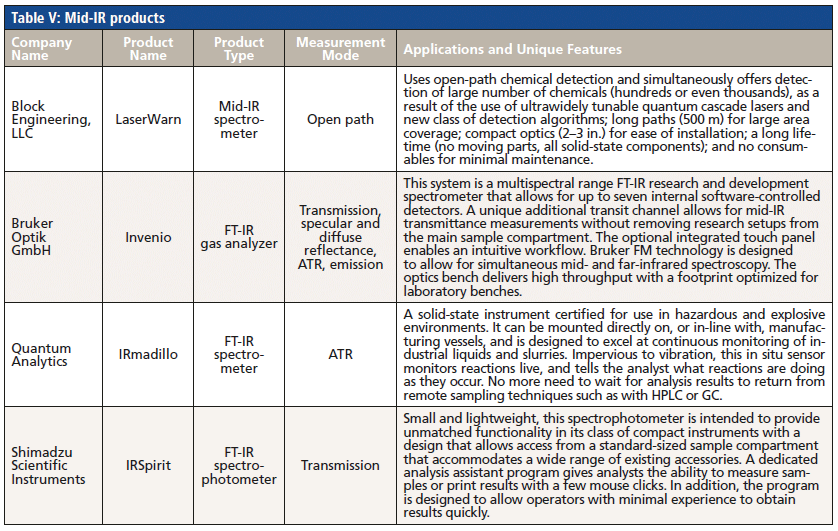
Block Engineering has configured QC lasers for a breakthrough in openpath chemical detection and measurement that simultaneously offers detection of large numbers of chemicals (hundreds or even thousands), resulting from the use of world-record, ultrawidely tunable quantum cascade lasers, and a new class of sophisticated detection algorithms.
Bruker offers a multispectral range FT-IR R&D spectrometer with many innovative features, including detector technology that allows for up to seven internal software-controlled detectors. A unique additional channel allows for mid-IR transmittance measurements without removing research setups from the main sample compartment.
Quantum Analytics has introduced a solid-state instrument certified for use in hazardous and explosive environments. It is mounted directly on, or in-line with, manufacturing vessels, and excels at continuous monitoring of industrial liquids and slurries. Impervious to vibration, this in situ sensor monitors reactions live.
Shimadzu Scientific Instruments provides unmatched functionality in its class of compact instruments with a design that allows access and a standard-sized sample compartment that accommodates a wide range of existing accessories.
NIR
This year, there was a lot of activity around NIR instrumentation (Table VI). Portability was a major theme of offerings from companies such as BaySpec, Spectral Evolution, and Spectral Engines. Food-targeted analyzers were also developed by Brimrose and Avantes, showing that the analyzer theme seen some years back continues in the NIR space, but at a slowed pace. Adaptation of existing equipment into the NIR space was also shown by PerkinElmer.
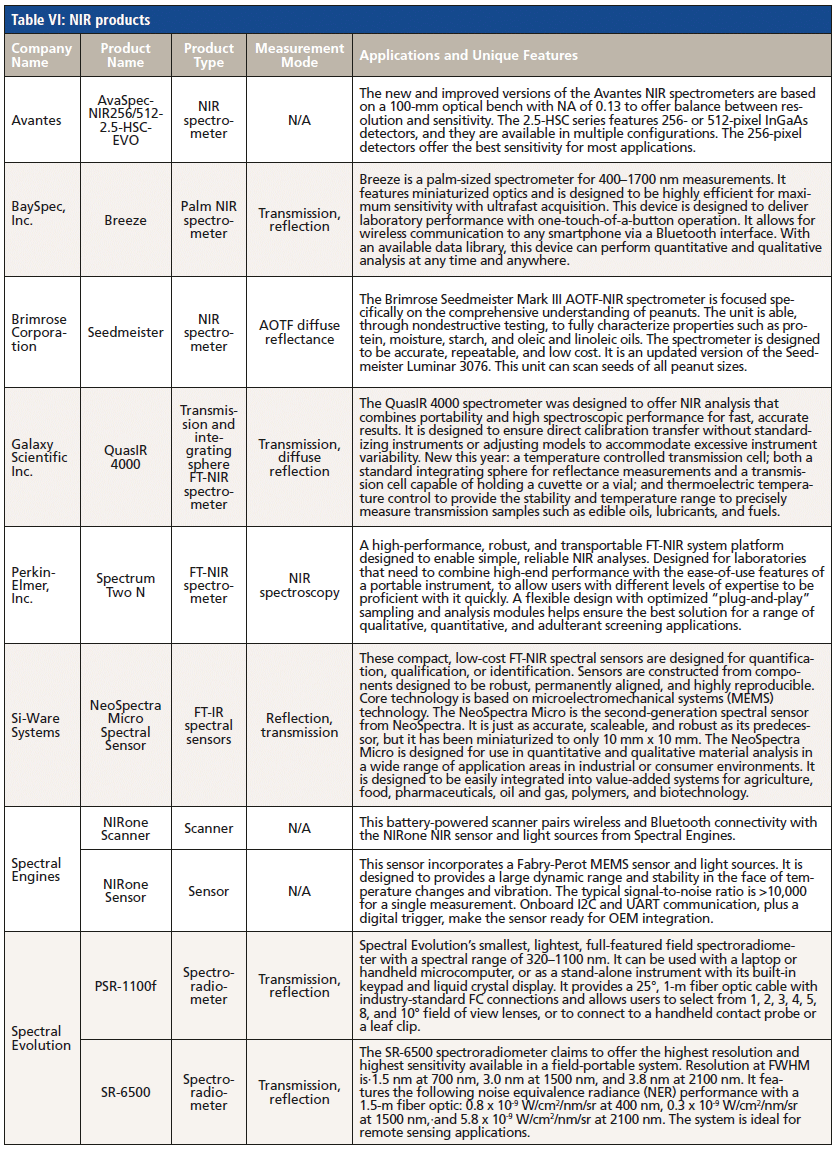
Another general trend that started off slowly a while back and seems to be continuing is for manufacturers to provide instruments precalibrated for the commodities (and the analytes in those commodities) that their customers want to measure.
Avantes has new and improved versions of NIR spectrometers that are based on a 100-mm optical bench with a numerical aperture (NA) of 0.13 that offer an optimal balance between resolution and sensitivity. The 2.5-HSC series spectrometers feature 256- or 512-pixel InGaAs detectors and are available in multiple configurations.
Bayspec has the world’s smartest palm spectrometer, the Breeze spectrometer for the 400–1700 nm range. Featuring proprietary miniaturized optics, the spectrometer is highly efficient for maximum sensitivity with ultrafast acquisition.
The Brimrose Seedmeister Mark III acousto-optic tunable filter (AOTF)-NIR spectrometer is focused specifically on the comprehensive understanding of peanuts. The unit is able through nondestructive testing to fully characterize such properties as protein, moisture, starch, oleic, and linoleic oils.
The Galaxy QuasIR 1000 NIR spectrometer ensures direct calibration transfer without the frustration of standardizing instruments or adjusting models to accommodate excessive instrument variability. Edible oils, lubricants, and fuels can be easily analyzed for quality control or adulteration.
PerkinElmer’s Spectrum Two N spectrometer is a high-performance, robust, and transportable FT-NIR system platform enabling simple, reliable NIR analyses, ideal for laboratories that need to combine high-end performance with the ease-ofuse features of a portable instrument.
Si-Ware Systems provides a compact, low-cost FT-IR spectral sensor that delivers the spectral response of the light absorbed by materials for quantification, qualification, or identification.
Spectral Engines provides an NIR sensor that incorporates a Fabry-Perot microelectromechanical systems (MEMS) sensor and light sources. The NIRone NIR sensor has a large dynamic range and stability in the face of temperature changes and vibration, and also offers a battery-powered scanner that pairs wireless and Bluetooth connectivity with the NIRone NIR sensor and light sources.
Spectral Evolution has its smallest, lightest, full-featured field spectroradiometer that has a spectral range of 320–1100 nm and can be used with a laptop or handheld microcomputer, or as a standalone instrument with its built-in keypad and liquid crystal display (LCD). It provides a 25°, 1-m fiber-optic cable with industry-standard FC connections and allows users to select from 1, 2, 3, 4, 5, 8, and 10° field of view lenses or connect to a handheld contact probe or unique leaf clip.
NMR and ESR
Only one manufacturer, Magritek, showed new instrumentation, continuing to develop the benchtop NMR area. This area (Table VII) continues to show increasing promise as the fields increase, improving sensitivity and providing access to more nuclei. There are also related developments in NMR–electron spin resonance (ESR) methods applied to specific markets.
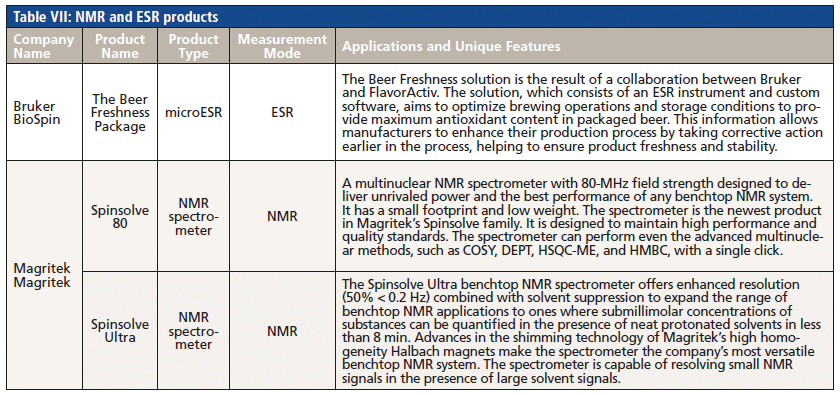
Bruker’s Beer Freshness solution, consisting of an ESR instrument with custom software and database, is the result of a collaboration between Bruker and FlavorActiv. The solution aims to optimize brewing operations and storage conditions to provide maximum antioxidant content in packaged beer.
Magritek has a carbon benchtop NMR spectrometer that provides remarkable 60-MHz NMR performance in a compact, benchtop instrument including 1D and 2D NMR experiment capability, with 1H, 19F, and 13C nuclei.
Raman
Recent trade shows like Pittcon have seen many new Raman systems being shown (Table VIII). While fewer new devices appeared this year, there were innovations, especially around small scale and original equipment manufacturer (OEM) instruments. The most unusual entrant this year, from TimeGate Instruments, strives to eliminate the old enemy of Raman- fluorescence-through time gating of the signal.
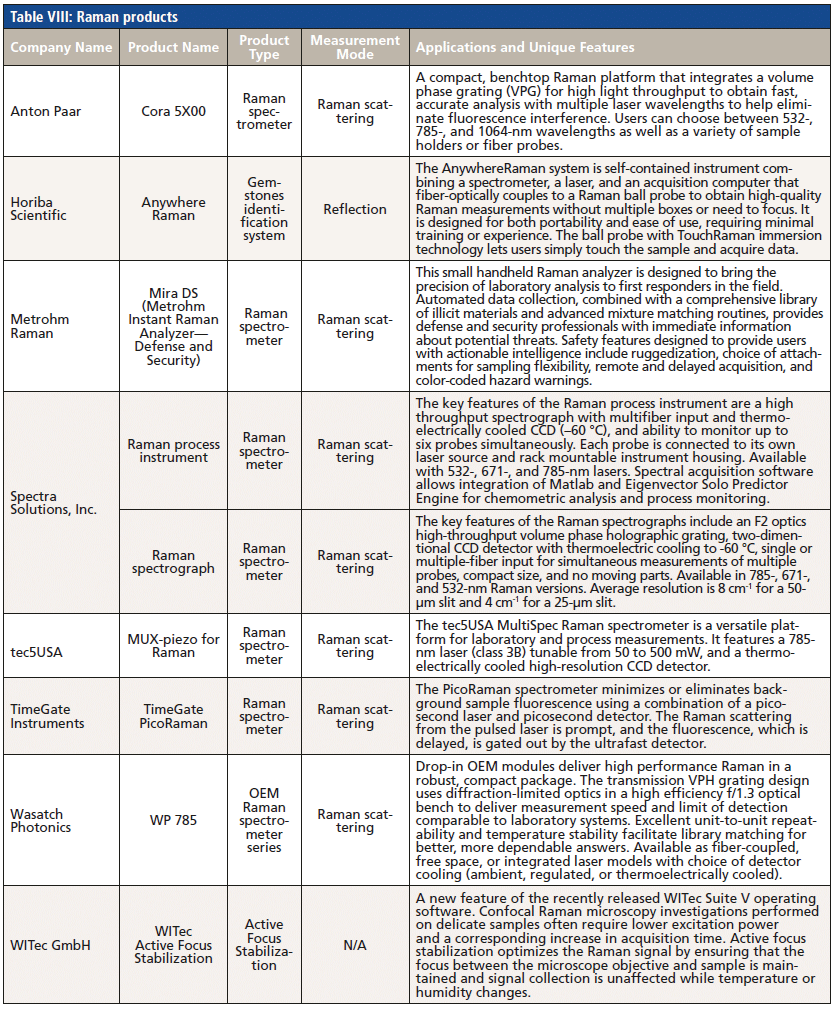
Anton Paar has a compact, benchtop Raman platform that integrates a volume phase grating for high light throughput.
Horiba Scientific manufactures and combines a spectrometer, laser, and acquisition computer in one instrument that fiber-optically couples to a Raman ball probe to obtain high-quality Raman measurements without multiple boxes or need to focus.
Metrohm shows the smallest handheld Raman analyzer available, designed to bring the precision of laboratory analysis to first responders in the field.
Raman process instruments from Spectra Solutions include a high- throughput spectrograph with multifiber input and thermoelectrically cooled CCD (-60 °C) and can monitor up to six different probes simultaneously. Each probe is connected to its own laser source and rack-mountable instrument housing.
The tec5USA MultiSpec Raman system is a versatile platform for laboratory and process measurements. It features a 785-nm laser (class 3B) variable from 50 to 500 mW, and a thermoelectrically cooled high-resolution CCD detector.
Timegate Instruments eliminates background sample fluorescence using a combination of a picosecond laser and picosecond detector. The Raman scattering from the pulsed laser is prompt, and the fluorescence, which is delayed, is gated out by the ultrafast detector.
Wasatch Photonics offers a drop-in OEM module that delivers high-performance Raman spectroscopy in a robust, compact package.
WITec’s Active Stabilization software feature optimizes the Raman signal by ensuring that the focus between the microscope objective and sample is maintained, even in the face of changes in the environment.
UV–vis
UV–vis instruments (Table IX) are workhorses in the analytical laboratory. With a long history of applications and new ones arising-especially in the pharmaceutical world-many vendors continue to develop these tools. The improvements center around speed of the analysis, decreasing the sample size, and increasing the sensitivity in a smaller instrument.
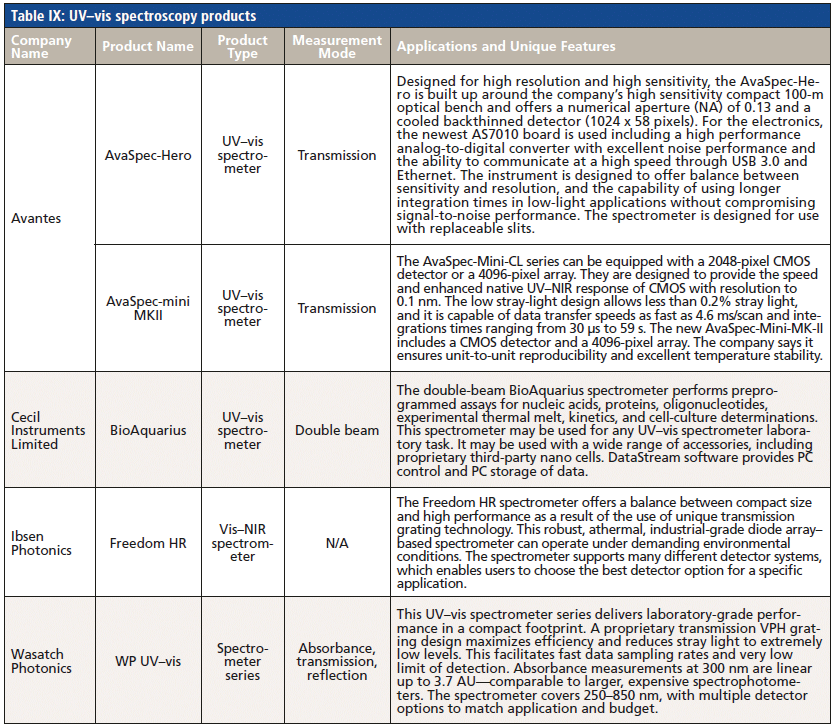
Avantes presents two new instruments, the Hero and the MKII UV–vis spectrometers. The former instrument emphasizes spectral sensitivity, and the latter features a detector array with more pixels for better spatial resolution.
Cecil Instruments has a double-beam instrument that can perform preprogrammed assays.
Ibsen’s Freedom C spectrometer introduces a new 4096px detector that enables higher resolution for the UV region down to 0.15 nm.
Wasatch Photonics has a new UV–vis spectrometer series that delivers analytical laboratory-grade performance in a compact footprint. Its proprietary transmission volume phase holographic grating design maximizes efficiency and reduces stray light to extremely low levels.
X-ray
Both companies in this section of the review introduce X-ray equipment (Table X) that stresses small spot sizes and speed of response.
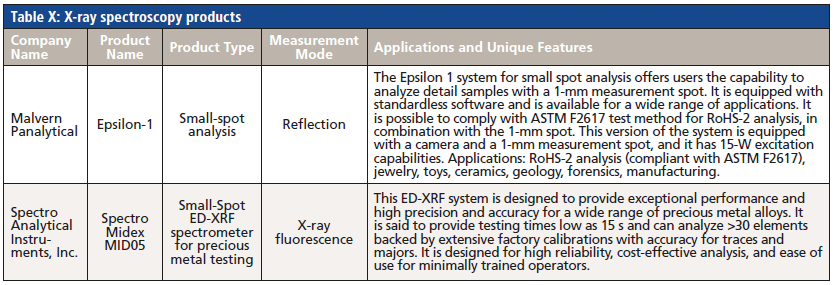
Malvern Panalytical (formerly Malvern) supplies the Epsilon 1 analyzer for small-spot X-ray analysis, which offers users the capability to analyze samples with a 1-mm measurement spot.
The Midex MID05 energy dispersive X-ray fluorescence spectrometer from Spectro Analytical Instruments is designed to provide exceptional performance, high precision, and accuracy for a wide range of precious metal alloys, with testing times as low as 15 s, for more than 30 elements backed by extensive factory calibrations.
Software
Software (Table XI) consists of several different, albeit related, types of products. The first, and arguably the main type, is actual computer programs (that is, the sequences of instructions computers use to carry out their functions).
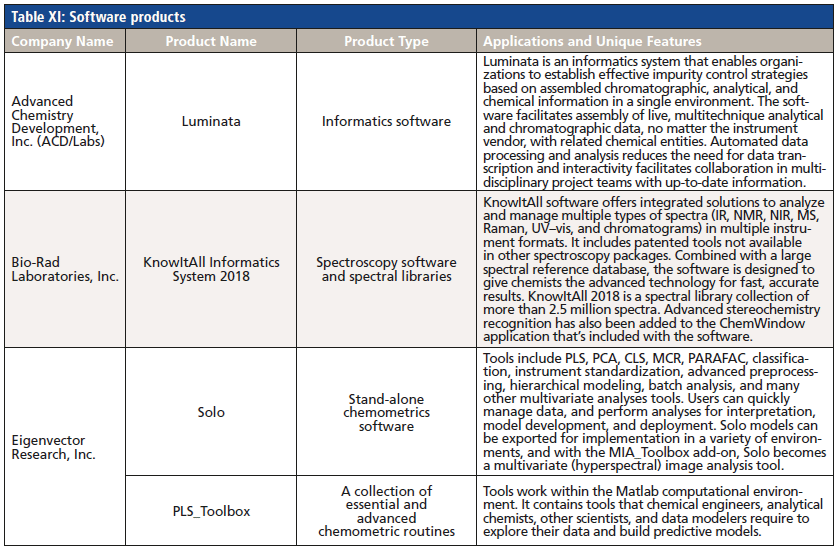
A large number of new software products appeared this year. The software interface and the attainment of results are now the core of user experience. Clearly, helping users move rapidly from a sample to a result is becoming a major goal of both instrument developers and pure software companies. There is also movement in the area of spectral libraries (vibrational and MS), as new materials and new demands are causing the industry to reach for new reference standards to hit customer targets.
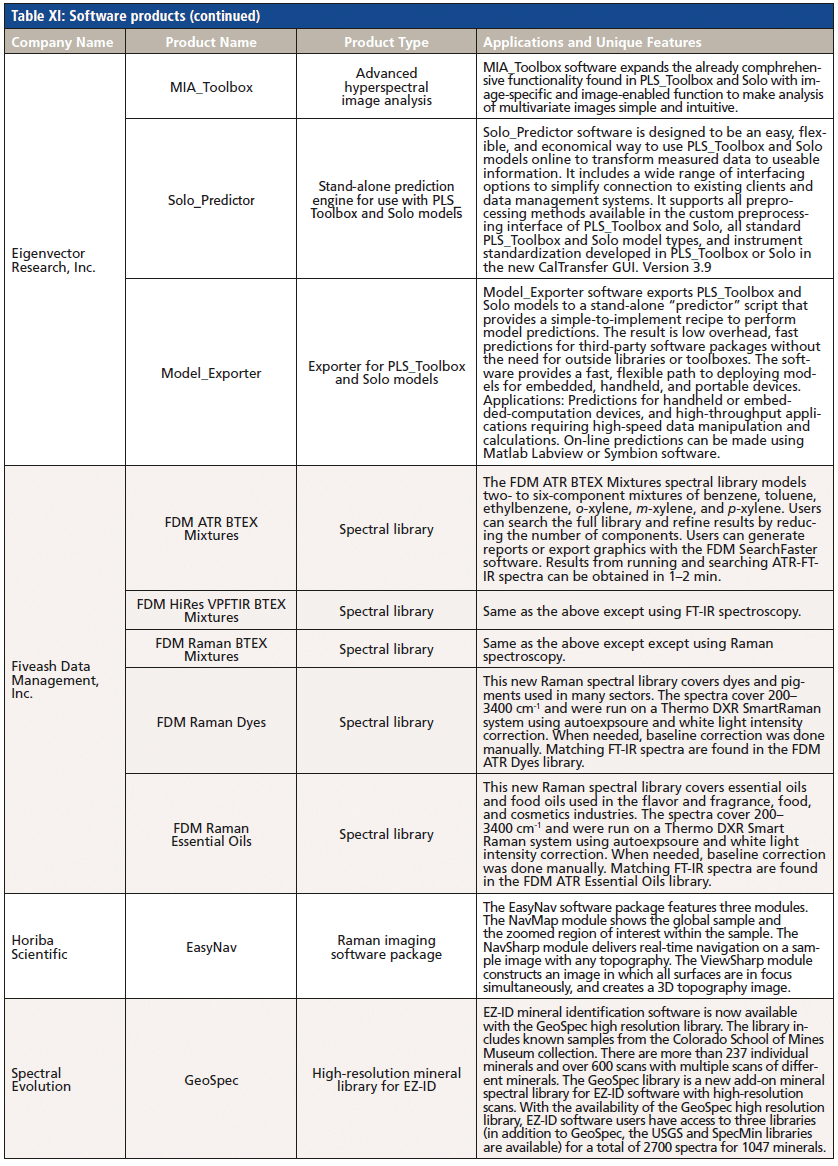
The second type of product consists of collections of various types of data. One important subcategory of this product type consists of actual databases- sets of related data that can be used in a manner similar to dictionaries or encyclopedias (as compendia of important facts and relationships among those facts).
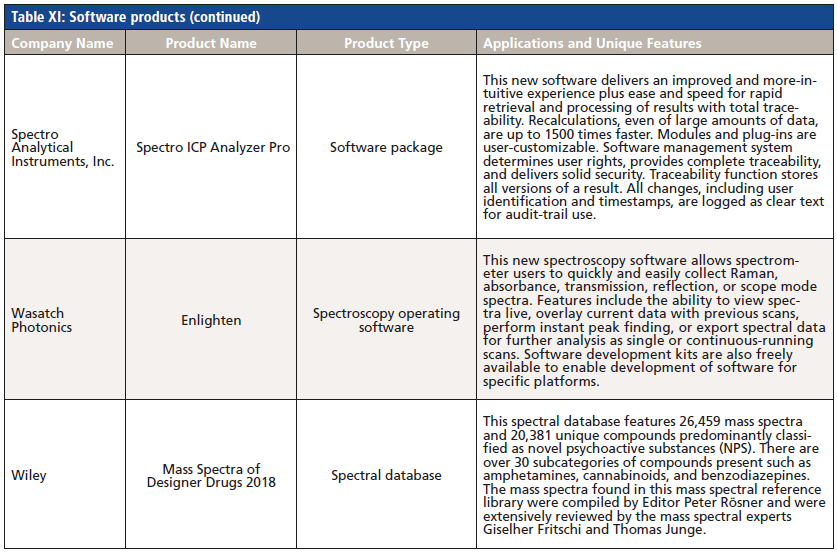
A third type of product that we would include under the heading of “software” is somewhat unique to the fact that spectroscopy is heavily dependent on chemometric algorithms. This software, therefore, consists of the models, or collections of models (that is, a “database” of models) that can be used by the chemometrics algorithms to analyze future samples. This category tends to be promoted by instrument manufacturers to further their interest in selling instruments without requiring the user to calibrate them.
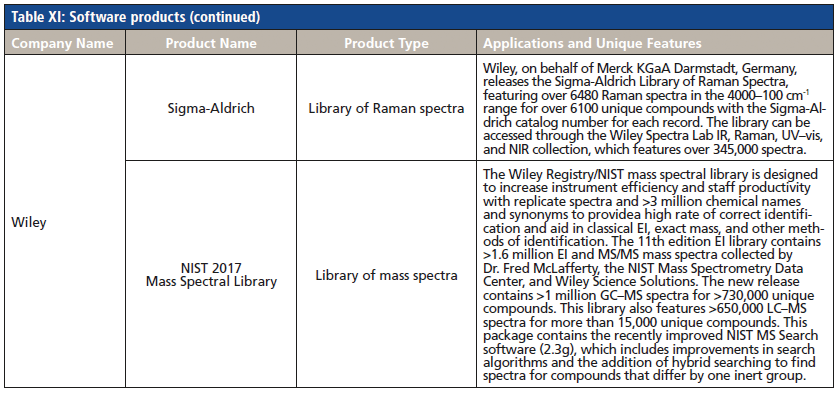
The final type in “software” is not readily definable but consists of a group of miscellaneous offerings that provide something other than hardware (for example, nondigitized spectral libraries).
Advanced Chemistry Development (ACD/Labs) provides an informatics system that enables organizations to establish effective impurity control strategies based on assembled chromatographic, analytical, and chemical information, in a single environment.
BioRad is offering a 2018 version of its KnowItAll package that includes upgraded software and new and expanded databases.
Eigenvector Research has a stand-alone software package that implements its key algorithms without needing MATLAB support.
Fiveash Data Management provides spectral libraries for different classes of materials, including benzene, toluene, ethylene, and xylenes (BTEX), dyes, and essential oils using various types of spectroscopy, including attenuated total reflectance (ATR), vapor-phase FT-IR, and Raman spectroscopy. The BTEX Mixtures models two- to six-component mixtures of benzene, toluene, ethylbenzene, o-xylene, m-xylene, and p-xylene.
Horiba Scientific’s new software package includes three key programs: NavMap, NavSharp, and ViewSharp.
Spectral Evolution’s software package is now available with the GeoSPEC High Resolution Library EZ-ID mineral identification software.
Spectro Analytical Instruments has a new software package that delivers a greatly improved and more intuitive experience plus unequaled ease and speed for the rapid retrieval and processing of results with total traceability and natural, streamlined workflows backed by ultrafast data processing.
Wasatch offers spectroscopy software that allows spectrometer users to quickly and easily collect Raman, absorbance, transmission, reflection, or scope-mode spectra at no additional cost. Features include the ability to view spectra live, overlay current data with previous scans, perform instant peak finding, or export spectral data for further analysis as single or continuous-running scans. The company also offers a software development kit.
Wiley is providing a mass spectral library of designer drugs, the Sigma-Aldrich library of Raman spectra, and the NIST 2017 library of mass spectra.
Accessories
The large number of accessories introduced this year (Table XII) covers the two main features needed: preparation of a sample for analysis or new ways to bring the sample into position for analysis. In all cases, the idea is to remove a pain point either to simplify the laboratory workflow or to ensure a sample is brought into position efficiently.
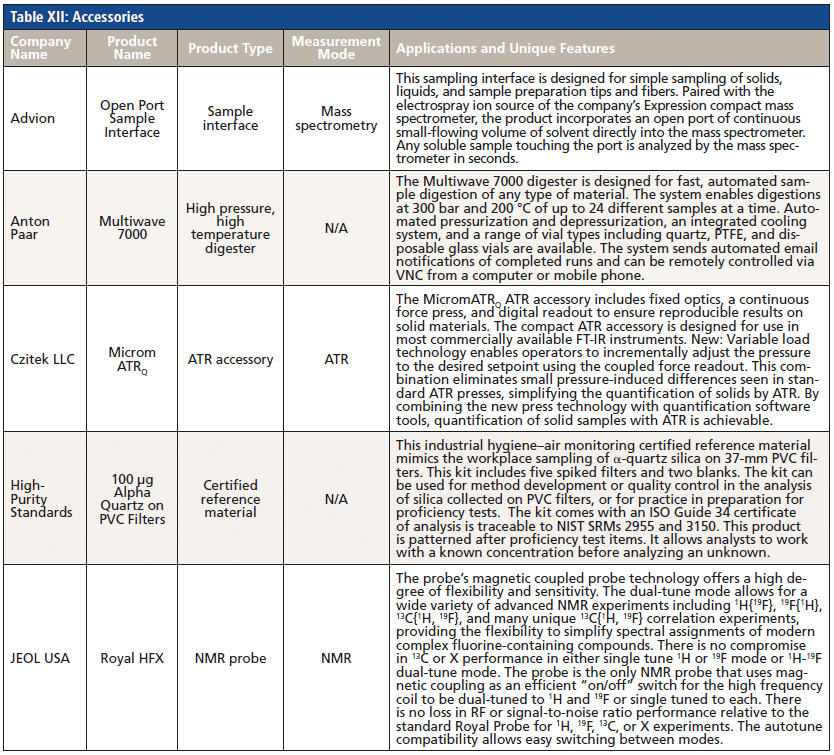
High-throughput analysis got attention with both ATR and terahertz Raman new products. Past years have seen developments around fluorescence, so these devices are bringing new flexibility to screening laboratories.
Advion provides an open port sampling interface (OPSI) that is designed for simple sampling of solids, liquids, and sample preparation tips and fibers. The interface is designed to pair with the electrospray ion source of the company’s Expression compact mass spectrometer.

Anton-Paar’s Multiwave 7000 system enables fast, automated sample digestion of any type of material by digesting at the high temperature and pressure of 300 bar and 200 °C for up to 24 different samples at a time.
Czitek shows the MicromATRQ ATR accessory with digital force readout. The accessory includes fixed optics, a continuous force press, and digital readout to ensure reproducible results on solid materials. The compact ATR accessory can be used with most commercially available FT-IR spectrometers.
High Purity Standards offers a certified reference material that mimics the workplace sampling of α-quartz silica on 37-mm polyvinyl chloride (PVC) filters. This kit includes five spiked filters and two blanks.
JEOL’s patented magnetic coupled probe technology offers significantly more flexibility and sensitivity than alternatives.
JM Science provides a large selection of high-quality UV quartz cells.
Ondax has a transmission Raman probe accessory designed to enable fast, easy, low-frequency transmission Raman measurements on tablets and vials.
PIKE Technologies has the AutoATR accessory, which comprises a new ATR crystal that has been functionalized with multiple microprisms.
Savillex provides hotplates that give unmatched temperature uniformity across the heating surface, providing greater control over sample digestion and evaporation.
Specac Limited provides a quick-release die that is an intuitive solution to awkward and time-consuming sample pellet extraction.
Spectral Solutions provides very compact form factor, user-replaceable fiber-optic cables, and a user-replaceable focusing lens barrel, including a high-pressure (6000 psi) and high-temperature (300 °C) version
The EZSlicer compact precision cutting device from S.T. Japan-Europe GmbH is designed to easily and accurately cut sections of thin materials such as packaging materials, films, laminates, paper, and fibers. It allows control of section thickness down to 20–30 µm.
Thermo Fisher Scientific provides an articulated opto-mechanical arm that measures samples too large to fit into an FT-IR spectrometer sample compartment. The articulated arm simplifies sample analysis with the object in front, below, or above the spectrometer sample compartment.
Components
When it comes to components (Table XIII), we raise the same question every year: What’s the difference between a component and an accessory? We say this so that we don’t get in arguments over the classification of some particular instrument or other. So, it still needs to be repeated: A component is something that can be used in the construction of an instrument and becomes an inherent part of it; if it’s not there, then the instrument will not work or at least be severely degraded. An accessory is a device that can be used optionally in conjunction with an instrument and is generally external to it. The instrument will work just fine without the accessory, but it extends the instrument’s capabilities (for example, a liquid f low cell for an instrument innately designed to measure solid samples). The accessory can be removed to return the instrument to its previous performance level, whereas a component generally cannot be removed except by a factory trained expert.

This year, optical components seemed to predominate. An interesting development in components involved the release by two companies, Spectro-Light and Energetiq Technology, of new white light sources of high luminosity and performance. In a field dominated recently by lasers, this is a striking development. Most laser system manufacturers were discussing upgrades and updates. There was also discussion of new mirror processing and a novel approach to wavelength selection.
Cobolt has released several new wavelengths in its 08-01 series of lasers, which consists of high performance, ultracompact, single longitudinal mode (SLM) diode pumped lasers (08-DPL) up to 400 mW. Available wavelengths include 457, 473, 515, 660, and 1064 nm.
Elec t ro-Opt ic s Technolog y’s compact optical isolators eliminate frequency instability in single-frequency laser diodes, parasitic oscillations resulting from amplified spontaneous emission (ASE) in amplified laser systems, and generally protect your laser system from under-performing or damage resulting from optical feedback.
Energetiq Technology provides the EQ-9 LDLS laser-driven light source, which offers the highest radiance and irradiance available in a truly broadband white light source.
Laser Components makes superior thermoelectric coolers (TEC) for PbSe/PbS detectors leverages mid-IR detection. These improved heat pumps achieve the same ΔT with less required cooler power. Better feedback control of the TEC top stage maintains detector temperature stability.
Princeton Instruments has a CCD camera for spectroscopy. The company’s Blaze proprietary HR sensors deliver the highest quantum efficiency (QE) in the NIR region, with ~90% from 690 to 960 nm, ~95% from 800 to 900 nm, and 75% at 1000 nm.
Spectrolight provides optical accessories, including a bright white light source and a wavelength selector that can provide interference-filter optical characteristics.
Spect rum Scient i f ic provides Freeform mirrors, which are curved mirrors with no axial symmetry that allow compound compensation, meaning that a single optic can replace multiple optics, thereby reducing the system volume and allowing for increased aberration correction.
Reference
(1) https://pittcon.org/exhibitor/pittcon-demographics.
Howard Mark serves on the Editorial Advisory Board of Spectroscopy and is a regular coauthor of the “Chemometrics in Spectroscopy” column. He also runs a consulting service, Mark Electronics, in Suffern, New York. Mike Bradley also serves on Spectroscopy’s Editorial Advisory Board and is a Senior Manager, Product Applications at Thermo Fisher Scientific in Madison, Wisconsin. Direct correspondence to hlmark@nearinfrared.com
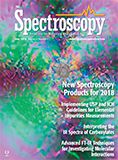
Best of the Week: AI and IoT for Pollution Monitoring, High Speed Laser MS
April 25th 2025Top articles published this week include a preview of our upcoming content series for National Space Day, a news story about air quality monitoring, and an announcement from Metrohm about their new Midwest office.
LIBS Illuminates the Hidden Health Risks of Indoor Welding and Soldering
April 23rd 2025A new dual-spectroscopy approach reveals real-time pollution threats in indoor workspaces. Chinese researchers have pioneered the use of laser-induced breakdown spectroscopy (LIBS) and aerosol mass spectrometry to uncover and monitor harmful heavy metal and dust emissions from soldering and welding in real-time. These complementary tools offer a fast, accurate means to evaluate air quality threats in industrial and indoor environments—where people spend most of their time.